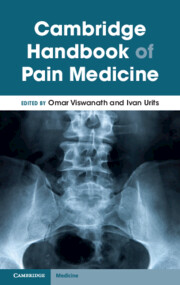Book contents
- Cambridge Handbook of Pain Medicine
- Cambridge Handbook of Pain Medicine
- Copyright page
- Contents
- Contributors
- Pain Handbook Introduction
- Part I Introduction to Pain: Pain Signaling Pathways
- Part II Common Categories of Pharmacologic Medications to Treat Chronic Pain
- Part III Chronic Pain Conditions Head and Neck
- Part IV Spine
- Part V Extremities
- Part VI Misc
- Part VII Adjunctive Therapy
- Chapter 39 Neuromodulation
- Chapter 40 Regenerative Medicine
- Chapter 41 Cognitive Therapy
- Chapter 42 Alternative Therapy
- Chapter 43 Role of CBD in Chronic Pain
- Index
- References
Chapter 39 - Neuromodulation
from Part VII - Adjunctive Therapy
Published online by Cambridge University Press: 01 December 2023
- Cambridge Handbook of Pain Medicine
- Cambridge Handbook of Pain Medicine
- Copyright page
- Contents
- Contributors
- Pain Handbook Introduction
- Part I Introduction to Pain: Pain Signaling Pathways
- Part II Common Categories of Pharmacologic Medications to Treat Chronic Pain
- Part III Chronic Pain Conditions Head and Neck
- Part IV Spine
- Part V Extremities
- Part VI Misc
- Part VII Adjunctive Therapy
- Chapter 39 Neuromodulation
- Chapter 40 Regenerative Medicine
- Chapter 41 Cognitive Therapy
- Chapter 42 Alternative Therapy
- Chapter 43 Role of CBD in Chronic Pain
- Index
- References
Summary
Spinal cord stimulation (SCS) and peripheral nerve stimulation (PNS) are treatmentmodalities that take advantage of gate theory of nociception first described by Ronald Melzack and Patrick Wall in 1965. Types of neuromodulation: SCS, dorsal root ganglion stimulation (DRG), and PNS. Spinal cord stimulation is an important modality in wake of increased use of opioids in chronic pain patients and increased rates of opioids use disorder and dependence. Some indications of neuromodulation, such as SCS, include failed back surgery syndrome (FBSS), complex regional pain syndrome (CRPS), neuropathic and ischemic pain, and refractory angina pectoris (RAP). Psychologic screening is necessary in determining patient selection for SCS treatment. Trial period of SCS is essential for predicting outcomes and further identifying which patients should undergo permanent SCS implantation. Conventional SCS works by delivering electrical impulses at specific frequencies to dorsal columns of spinal cord, with the objective of producing paresthesia overlapping with existing distribution of pain, thus distorting the perception of delivered pain. Success is dependent upon pain surgeon’s ability to provide coverage over patients’ distribution of pain and patients’ willingness to tolerate possible induced sensations of paresthesia. The lead type, anesthesia, waveform programming are considerations for optimal patient-specific management of chronic pain with SCS. Long-term cost-effectiveness for treatment of chronic pain is compared to alternative treatment modalities.
Keywords
- Type
- Chapter
- Information
- Cambridge Handbook of Pain Medicine , pp. 319 - 326Publisher: Cambridge University PressPrint publication year: 2023



